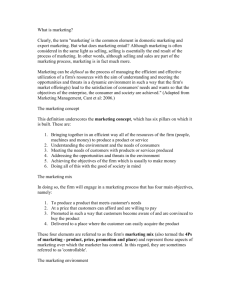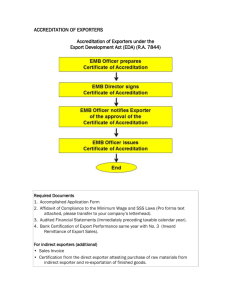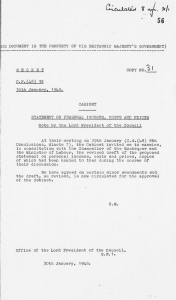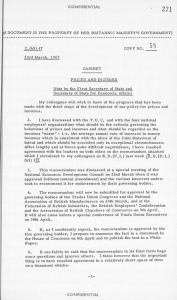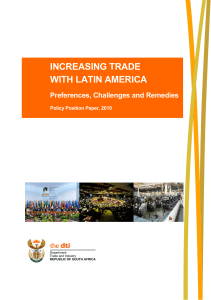Discussion Forum on « Why Trade Matters in Development Strategies » Presentation
advertisement
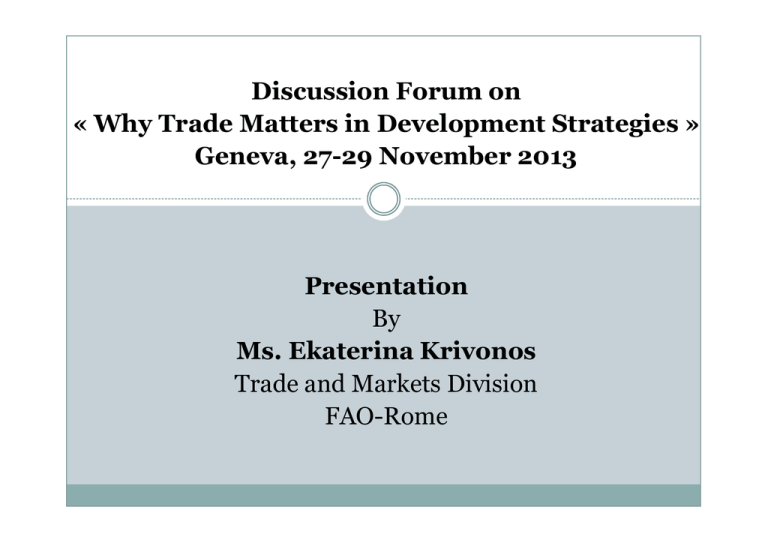
Discussion Forum on « Why Trade Matters in Development Strategies » Geneva, 27-29 November 2013 Presentation By Ms. Ekaterina Krivonos Trade and Markets Division FAO-Rome Trade, Agriculture and Food Security TRADE POLICY ISSUES IN DEALING WITH FOOD SECURITY Ekaterina Krivonos Trade and Markets Division FAO-Rome Food security dimensions Millennium Development Goals: Goal 1: Eradicate extreme poverty and hunger Targets: between 1990 and 2015, halve the proportion of people who suffer from hunger Progress: 980 million in 199092; 852 million in 2010-12 Food security exists when all people, at all times, have physical, economic and social access to sufficient, safe and nutritious food which meets their dietary needs and food preferences for an active and healthy life Trade policy and food security Changes in trade policy affect the relative prices of goods and factors => Both food production and consumption are affected Different impacts on different segments and population groups Examples: An export ban can boost domestic supplies and reduce prices in the shortrun. Good for consumers and domestic food processors, bad for agricultural producers who export. Trade liberalization is likely to reduce food prices to consumers and benefit competitive farmers, but the incomes of other farmers, and their food security, may be negatively affected. Trade and food security – conceptual linkages Possible effects of open trade Positive Negative Availability Access Utilization Stability (Supply: food (Incomes, (Nutrition and food (Weather political safety) production, stock expenditure, markets instability, economic levels and net trade. and prices) factors ↑ Quantity and variety • Net food importers:↓ • ↑ Variety of available • ↓ Seasonality of of food available Food prices foods supplies • ↑ Incomes in • ↑ Food safety and • ↑ Imports mitigate quality competitive sectors local production risks • ↓ Input prices and access to technology • ↑ Growth, FDI and employment • Net food exporters: ↓Own production available for domestic consumption • Net food importers: ↓ Domestic food production • Net food exporters Food prices ↑ • ↓ Incomes in sensitive / noncompetitive sectors • ↑Consumption of high calorie / low nutritional value foods • ↓ Consumption of traditional and indigenous foods • ↓ Own food production • ↑ Price volatility from global markets • ↑ Land grabbing • ↑ Less space for trade policy response Trade and food security Lessons from Latin America Some countries (Argentina, Bolivia, Ecuador) resorted to export restrictions in combination with subsidies to producers to counter high food prices. In the short run these increased domestic supplies, but export bans can generate smuggling and a negative supply response by producers. Brazil and Mexico used the existing safety nets to support poor consumers Trade measures were easiest to implement. The type of measure is determined by the country’s net trade position and the political environment Many times one (distorting) policy measure required implementation of second and third to remedy the effects Policy predictability is a major issue in some countries and undermines the intended effects Country example: Dominican Republic Rice prices in US and some Latin America countries, January 2007 – December 2009. Strong government involvement in the rice sector: Producer subsidies and import restrictions Critical constraints to effective participation of developing countries in the global trading system Inclusive and efficient global market systems Countries need specific and different national strategies and policies to benefit from international trade, improve livelihoods and pursue their own food security objectives (while taking account of food security needs elsewhere). • We need to address differences in opportunities among developing and developed countries (asymmetries). • The distribution of the benefits from participation in trade has been very uneven. We need to improve international trading systems and countries’ capacity to participate in them. • FAO’s support to developing and mainstreaming appropriate trade policy FAO provides information and analysis, facilitates evidence based policy advice and offers technical support to enhance the capacity of countries to deal with trade reforms in relation to agriculture. FAO has been supporting Ministries of Agriculture in developing capacities for trade negotiations and implementation of trade agreements. Examples of country-level trade policy support: • • • • • Russia and other CIS countries: Issues in domestic support to agriculture in the context of WTO accession Africa: Supporting African countries in boosting intra-trade through the formation of the Continent-wide Free Trade Area (CFTA) Latin America and Caribbean: Implementation of mechanisms to strengthen and expand intra-regional trade in food products Haiti: Revision of import tariffs on agricultural and food products Zambia: Policy recommendations for the maize marketing reform (state trading and stock management)


